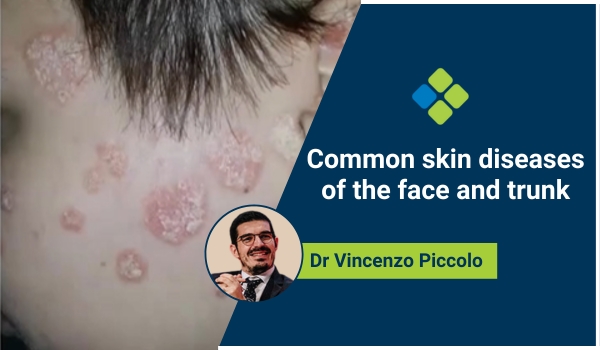How to manage severe sunburn in primary care
Read about early intervention measures to help control symptoms of severe sunburn and prevent complications like dehydration, infection, and skin damage.

HealthCert Education
Severe sunburn is common, particularly during the summer months. While mild sunburn can often be managed with simple supportive care, severe sunburn may require a more structured approach to prevent complications including dehydration, infection, or long-term skin damage.
This article outlines the key steps for GPs in managing patients presenting with severe sunburn.
Assessment and diagnosis
The first step in assessing and diagnosing severe sunburn in primary care is taking a complete history. This includes:
- Duration and intensity of sun exposure
- Use of sun protection (e.g. sunscreen, clothing, shade)
- Presence of systemic symptoms (e.g. fever, nausea, dizziness, confusion)
- Any prior history of severe sunburn or photosensitivity disorders
The next step is a physical examination. This means observing the extent of erythema, blistering, and skin peeling and looking for signs of dehydration, such as dry mucous membranes, tachycardia, and hypotension. Also, it is vital to search for evidence of a secondary infection (pus, increased warmth, erythematous streaking, etc.) and to give a neurological assessment, if confusion or heat illness is suspected.
How to manage severe sunburn in primary care
The basic management of severe sunburn in primary care focuses on:
- Pain relief,
- Skincare,
- Hydration,
- Prevention of secondary infections, and
- Addressing systemic symptoms.
Pain relief
- Nonsteroidal anti-inflammatory drugs (NSAIDs) such as ibuprofen or aspirin (if no contraindications) to reduce pain and inflammation.
- Acetaminophen as an alternative analgesic.
Skincare
- Cool compresses or cool (not cold) baths to soothe the skin.
- Application of fragrance-free moisturisers or aloe vera gel.
- Avoidance of petroleum-based products, which can trap heat.
- If blisters are present, advise against breaking them to prevent infection.
Hydration
- Encourage oral fluid intake (water, oral rehydration solutions).
- Consider intravenous fluids if there are signs of significant dehydration or heat exhaustion.
Prevention of secondary Infection
- Topical antibiotics for ruptured blisters if secondary infection is suspected.
- Systemic antibiotics only if cellulitis or systemic signs of infection develop.
Addressing systemic symptoms
- Monitor for heat-related illnesses and treat them accordingly.
- Manage nausea with antiemetics if needed.
Why are patient education and follow-up important?
It is essential to counsel all patients on sun safety and the importance of broad-spectrum sunscreen, protective clothing, and avoidance of peak sun hours.
Patients also need to be educated so they can recognise the signs of complications, such as worsening pain, fever, and spreading redness. These are the symptoms that require urgent care.
Scheduling follow-up appointments is always useful, particularly if significant skin damage or dehydration was present in the beginning.
When to refer a patient
Here’s an overview of the symptoms that require referral to a dermatologist:
- Extensive blistering or suspected second-degree burns covering a large body surface area.
- Signs of heat stroke or severe dehydration.
- Suspected secondary infection with systemic involvement.
- Persistent severe pain despite adequate analgesia.
Severe sunburn is often manageable in primary care. However, this condition requires a structured approach to control symptoms and prevent complications. Early intervention can significantly reduce morbidity and improve patient outcomes.
– Dr Rosmy De Barros
For further information on this topic, you may be interested to learn more about the HealthCert Professional Diploma program in General Dermatology.
How to claim CPD hours:
 Engaging with this blog can help meet your annual Education Activities CPD requirement! If you consume educational webinars, podcasts, articles, or research on this blog, you can Quick Log CPD hours with the RACGP via the usual self-submission process. You will be asked to reflect on what you have learned, and you will require supporting evidence such as a screenshot.
Engaging with this blog can help meet your annual Education Activities CPD requirement! If you consume educational webinars, podcasts, articles, or research on this blog, you can Quick Log CPD hours with the RACGP via the usual self-submission process. You will be asked to reflect on what you have learned, and you will require supporting evidence such as a screenshot.
Download the RACGP’s guide to self-recording your CPD here.
References
- Merin, K. A., Shaji, M., & Kameswaran, R. (2022). A Review on Sun Exposure and Skin Diseases. Indian journal of dermatology, 67(5), 625. https://doi.org/10.4103/ijd.ijd_1092_20
- Tan, S. T., Ernawati, E., Santoso, A. H., Firmansyah, Y., Tamaro, A., & Satyanegara, W. G. (2023). Community Service Activities–Education And Screening For Damage Of Facial Skin Hydration Caused By Sun Exposure In Adolescent Boys. Sejahtera: Jurnal Inspirasi Mengabdi Untuk Negeri, 2(2), 120-130.
- Rabbets, W. (2022). Don’t feel the burn–sunburn prevention and treatment. SA Pharmacist's Assistant, 22(4), 18-19.
- Soetrisno, K., Subchan, P., & Hussana, A. (2020). The Administration of Topical Aloe vera Extract Reduce the Number of Sunburn Cells and Expression of Caspase-3 on Post UVB-light-exposure Epidermis. Sains Medika: Jurnal Kedokteran dan Kesehatan, 11(2), 89-96.
- Richard, A. M. V., & Collipi Jr, R. (2019). heat StreSS. Handbook of Occupational Safety and Health, 335-357.

 1800 867 1390
1800 867 1390






